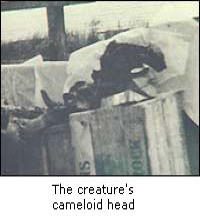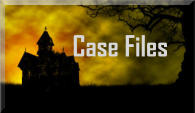While "Nessie" - the Loch Ness Monster - is considered their poster child, might there be other
creatures that inhabit lakes, seas and waterways all over the world? Some say the evidence
points overwhelmingly to the affirmative, while others maintain there is a startling absence of
hard evidence proving their existence. The scientific community places a premium on believable,
tangible evidence and will unfailingly dispute any claim falling well short of that criteria. For
instance, in cases of cyptids - where are the bodies? After all, if these things live, then they must
die. Lacking any ceremonial burials by their own species, surely some trace evidence would have
turned up by now. How can tales of these watery beasts still thrive despite all indications to the
contrary?
Yet reports of these creatures DO still persist and there are literally thousands around the
globe who lay claim to witnessing them. Some even possess what they claim is photographic
evidence that corroborates the anecdotal type. Is it possible these giant reptiles still exist as they
did millions of years ago beneath our waters and have somehow eluded all efforts so far to find
them? If no creature can live until the ripe old age of 10,000, can it be there are multiple
denizens of the same species alive under the waters of these ancient lakes?
Let's attempt to separate fact from fiction and present both sides of the argument in hopes of
drawing our own conclusions.
The sea monster in myth and legend has
existed for hundreds of centuries. In many
cases it is an expression of our fear, curiosity
and unawareness of what exists in the
uncharted regions of the sea. The ancient
Lenox Globe (seen pictured below), now
residing at the New York Public Library depicts
the known world in 1503-1507 is known to
have inscribed on it the words, "here there be
dragons" ('hic sunt dracones") on the eastern
coast of Asia (Kimodos?) as a cautionary notice
that one should venture no farther beyond the reaches of man's nautical capabilities. More likely,
this merely signaled unchartered territory.
It was a bold, yet convenient reasoning. Monsters could explain ocean storms, lightning
strikes, hurricanes or any weather anomalies not yet understood by our ancestors. An attack by a
sea monster was also the explanation of choice for any ships that ran aground, were damaged, or
sunk by unseen and unknown rock formations.
The Coelacanth (above), a heavy-bodied, many-finned fish with a three-lobed tail that was
thought extinct until it was caught in 1938 off the coast of South Africa. Since then two types of
coelacanth have been caught in five other countries: Comoros, Indonesia, Kenya, Madagascar and
Mozambique, according to African Coelacanth Ecosystem Program.
While the first reference to Nessie goes all the way back to the 6th century, the first modern
sighting of what was thought to be a living dinosaur was in the Scottish Highlands in 1933 by Mr.
& Mrs. George Spicer. They described the creature as having a large body (about 4 feet) high and
25 feet long, with a long, narrow neck, slightly thicker than an elephant's trunk and as long as the
ten- to twelve-foot width of the road.
Over the course of the summer, dozens of witnesses described a creature with a "snake-like
head", "long neck" and "humps sticking out of the water" swimming in the waters of Loch Ness.
The sightings were taken so seriously that Scottish officials announced that they were forbidding
anyone from shooting or trapping the serpent. It was about this time that photographs of "Nessie"
began to turn up. Many were quite dubious to say the least until April of 1943.
On April 21, 1943 the London Daily Mail published a photograph supposedly taken by Dr.
Robert Kenneth Wilson, a London gynecologist, of what appeared to be the Loch's most famous
inhabitant coming up for a quick look around. For over 60 years, most people pointed to this as
definitive proof that such a creature in fact did exist. However in 1992 a man named Christian
Spurling made a startling confession. According to Spurling, the photo was a hoax concocted by to
avenge his step-father, Marmaduke Wetherell, who was a big-game hunter. Wetherill submitted a
photo of footprints he maintained belonged to the creature, but the Daily Mail dismissed him as a
crank causing him not small level of embarrassment. Spurling extracted his revenge by creating a
"serpent" out of a toy submarine, placing a model of a head over the conning tower.
The model was then launched in the loch and the photo was snapped. By Spurling's account,
Wetherell persuaded Dr. Wilson to take credit for the shot. Perhaps fearing ridicule, Wilson never
admitted to his part in the hoax. Because the Daily Mail ran the photo on the front page of the
paper, Spurling in essence was saying, “If you want a hoax, I’ll give you a hoax”, in the process
making the publication look foolish when all was said and done. Despite this revelation, there are
many Nessie believers, many of them respected scientists and journalists, who argue the
admission is sour grapes and that it is no reason to discount other reports of the existence of the
creature.
Since the time Nessie became such a phenomenon, many other reports of similar creatures,
totaling in the hundreds, have surfaced around the world. Among the more famous (or infamous)
are: "Champ" the serpent said to inhabit Lake Champlain on the Vermont and New York borders.
The Ogopogo in Lake Okonogan, British Columbia, Canada. Nahuelito in the resort town of
Bariloche, Argentina. The Lake Storsjon Monster in Sweden and Morag in Loch Morar in the U.K.
What to make of these accounts? Has the anecdotal evidence handed down from generation to
generation been repeated enough to become the truth? Is science, with its rigid standards
regarding the burden of proof, doing enough to quantify the existence or non-existence of these
creatures? Among the witnesses to these events are very credible people who at least believe
they have seen something in the water. If they do not have the means (or good fortune) to
provide a body, does that rule out the possibility or even probability they have witnessed
something unusual and spectacular? Some in the scientific community have taken on the task of
proving/disproving their existence. In the 60s, many groups used sonar as the method of choice
to determine whether Nessie truly existed. This replaced the more mundane visual outposts
scattered around the lake. The results, while probably lacking the type of post-investigation
scrutiny presently associated with reported findings, spurred public interest. Large, moving
objects were located by the sonar rising and then descending into the depths of the waters.
While compelling enough, the true identity of the cause remains a mystery. By the late 60s,
small, manned submarines were brought in as well as sensitive
recording devices that bore some interesting, yet ultimately
unproven results.
The first truly scientific expedition to locate the Loch Ness
Monster took place in the 1970s when a group of Americans from
the Academy of Applied Science, led by Robert Rines, used sonar
technology and a submersible camera to take some highly unusual
photographs, the most controversial of which is the famous "flipper
shot" (right) taken in 1974. In this case, photo specialists from the
A.A.S. over-filtered the photo making a release of bubbles look like
an appendage.
If Nessie is a bit reticent about appearing in public, then by comparison the Ogopogo by the
many photographs taken of it, seems to be ready for People Magazine. The resident of Lake
Okanagan in British Columbia has reportedly been sighted, photographed and even videotaped
hundreds of times by chance visitors or curious onlookers. In some cases, multiple serpents have
seen seen on the lake.
The origin of the Ogopogo traces back to Native Indian tales of a fearsome lake serpent. The
creature, in fact was first known as "Naitaka" which translates to anything from "water demon" to
"sacred creature of the water". In Indian legend, the Naitaka would demand a toll to insure safe
passage around its home near Rattlesnake Island, located in the lake. The toll came in the form of
live animals, which would be dropped into the water as a sacrifice to the great Naitaka. A plaque
that commemorates the existence of the Ogopogo is located on Lake Okanagan. It reads:
"Before the unimaginative, practical white man came, the fearsome lake monster N'ha·a·itk was
well known to the primitive, superstitious Indians. His home was believed to be a cave at Squally
Point, and small animals were carried in the canoes to appease the serpent. Ogopogo is still seen
each year - but now by white men."
If the plesiosaur is a suspect in the Loch Ness mystery, then what of Ogopogo? Two scientists
who have spent over 20 years researching Ogopogo and compiling witness descriptions, Paul
LeBlond and Ed Blousefield, think it is Cadborosaurus Willsi, so-named because eyewitness
accounts describe it similar to a creature found in the belly of a whale back in 1937 (photos
below) and that has been sighted over the years in Cadboro Bay in Victoria, B.C.
LeBlond and Bousefield are also noteworthy for their disdain for those in the scientific
community that refuse to acknowledge the veracity of eyewitness accounts or the probability that
these types of aquatic animals may indeed exist. Bousefield feels that as the creature migrated up
the rivers to Lake Okonagan, following the salmon food source, it became land-locked as dams
were erected and lake properties developed, effectively sealing the animal off from more open
waters.
Over the years, there has been one thing that has separated claims of the existence of the
Ogopogo from other similar monsters of the deep.
Videotape. There are two that stand out from the others:
1968 - The Folden Film, a video taken by sawmill worker Arthur Folden of Chase, B.C.
depicting what appears to a large creature in shallow water breaking to the surface. It was shot
from the side of a hill overlooking the loch. Generally thought to be the classic Ogopogo video.
Folden was reluctant to show anyone the video, fearing ridicule, but was coerced into finally
releasing it to investigators about two years after it was taken. Skeptics point out that the object
on the film closely resembles what looks like a large water wake, perhaps caused by a passing
motorboat. It is known that the resulting waves of such a disturbance may take as long as 5
minutes to reach shore.
1992 - Paul DeMara Film - Three different pieces of footage are shot on a HI8 camera. The
first features what appears to be numerous "creatures" swimming side-by-side across the lake. As
a powerboat pulling a water-skier comes along, the objects seem to go under. It appears the boat
has a near-hit with one of the objects. The second part shows what appears to be a head and
neck, then three humps. The third shows a large object moving in the water. Video analysis shows
this could be what is called a "phantom wave". It is also strange to many that the driver of the
boat and the water-skier don't seem to react in any panic upon seeing the "creature".
The Canadian government certainly takes the Ogopogo seriously. Fearing the volume of
gawkers and tourists looking for the creature, they declared it an endangered species off-limits to
hunting or trapping.
His mother was an earwig
His father was a whale
A little bit of head
And hardly any tail
And Ogopogo was his name
In a body of water shared by Vermont, New York and Canada called Lake Champlain, there is
rumored to be a creature living there affectionately known as "Champ". In fact, to date there
have been over 300 sightings of the animal and some really interesting photographic evidence to
boot. It has been speculated that this reptile, like its cousin Nessie, is in fact a plesiosaur. In fact,
sightings of Champ pre-date those of Nessie by 50 years. There is however, based on recordings
taken below the surface of Lake Champlain, another theory that the animal in Lake Champlain
may be a new species of freshwater dolphin or whale based on a series of distinguishable "clicks"
that were heard. Or perhaps a giant lake sturgeon whose type have been reported to grow up to
10 feet long (or better).
(About plesiosaurs roaming these bodies of water, there are some issues to bear in mind. In
the case of Loch Ness, it was formed by glacial movement and didn’t become a lake until around
10,000 years ago. In 1933 a man named George Spicer was driving with his wife on the road
running parallel to the lake when they saw a creature that seemed to be crawling across the road
up ahead of them. It was a year later after this sighting that the whole Nessie phenomenon took
hold. Given the life expectancy of a plesiosaur, there would have had to been at least 5,000 of
them in the lake to have survived to Spicer’s sighting. There is also a problem with the name. Any
creature’s name that ends in “saur” means they are considered a lizard and therefore an air
breather. This means they would have to surface every few minutes for oxygen. The sightings
would have been astronomical and it’s unlikely any beast with a need for air would have gone
undetected for so long. Lastly, there is the matter of food. There are approximately 20 tons of fish
in Loch Ness, which would only be enough to sustain 2 tons of predator. Hardly enough to support
an entire population of that number and size. Oh, and their heads wouldn’t bend forward in such
an extreme manner as are usually depicted in photos and eyewitness accounts.)
Like other lake monsters, Champ has become something of a cottage industry unto itself and
a source of pride for residents of the surrounding areas. Port Henry, New York for example holds a
"Champ Day" festival each August and Vermont's baseball entry in the New York-Penn League is
known as the Vermont Lake Monsters. Like many of the others it is also on an endangered species
list to protect it from poachers, hunters or trappers. One wonders how one would go about about
trapping a 60-70 foot serpent, but we'll leave that to the experts like the famed huckster P.T.
Barnum, who offered $50,000 to anyone who could produce Champ for his road show.
Another similarity of note is the Native American influence on the legend. It is said that the
Iroquois and the Abenaki tribes spoke of such a creature in the lake and the Abenakis called it
"Tatoskok".
The most compelling photo of Champ was taken back in 1977 by a woman named Sandra
Mansi. In the photo, what appears to be a head attached to a long neck is sticking out of the
water (below).
While the photograph has puzzled some in the scientific community and been authenticated as
a "unknown" by some like George Zug of the Smithsonian Institute’s Department of Vertebrate
Zoology, others claim it very well may be a rolling tree or log which was forced to the lake's
surface by gases created by means of organic decay. There has also been a theory floated that
states in sum total that Champ is actually being seen because of a window in time ("time slips")
that are allowing us to see into the lake's past.
Oh, well now there you go. Case solved.
Ruining all the fun as usual is Joe Nickell of the Skeptical Inquirer who wrote after
investigating the lake, "For example, otters, swimming in a line, can mimic a single long,
serpentine creature moving in an undulating fashion. Other Champ suspects include wind slicks,
boat wakes, driftwood, long-necked birds, and many other possibilities. A contributing factor is
'expectant attention,' the tendency of people who, expecting to see something, are misled by
anything resembling [what they are looking for]."
Joe says nothing about the expectations of seeing nothing and getting exactly that.
Are the sightings of these creatures continuous proof of the various species of life out there
that remain unknown or is it merely a manifestation of human nature that wants to believe there
is something out there greater than ourselves?
Whatever may lurk beneath the surface of lakes around the world, there will always be those
who will work tirelessly to prove the existence of creatures from another time and those who will
work just as long and hard to dispel any notions of such claims. Believers will point to creatures
like the Coelacanth and the Megamouth Shark to prove that it is possible for a species to evade
discovery for generations at a time. Conversely, skeptics and non-believers will always cite the
overwhelming lack of physical evidence to support those claims.
The burden of proof may lay squarely on the witness to back up the story, but on the other
hand, how does one prove such things not only don't, but also can't exist in the modern world?
While debate over the existence of these elusive creatures is certain to continue for generations to
come, the legends will continue to grow and be passed down just as they did in ancient texts and
from the indigenous peoples of these lands.
And as they did before us, we will continue to be suspicious of the unknown but still
determined in our desire to pursue the truth.









LAKE MONSTER MYTHS AND LEGENDS
BY: KEN DECOSTA
“HERE BE DRAGONS”
THE SURGEON’S PHOTO
THE BURDEN OF PROOF, OR…HOW TO FIND A SEA MONSTER
THE STRANGE CASE OF THE OGOPOGO
THE (PHOTOGRAPHER) LADY AND THE CHAMP




























